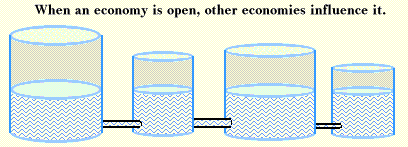International Payments and Limits on Policy
The State of Indiana does not have a macroeconomic policy, nor does Illinois, Ohio, or any other state. It does have macroeconomic problems. It can have rates of inflation that differ somewhat from the rates of the United States as a whole, and it can and usually does have rates of unemployment that differ noticeably from the national average. Yet it has no macroeconomic policies to deal with these problems.
The United States government also lacked policies to deal with macroeconomic problems in the 19th century. An important reason for the lack both of state macroeconomic policy today and federal macroeconomic policy in the 19th century is that both states today and the federal government a century ago existed as part of larger economies and were very open to these larger economies. State borders are open to the movement of people and capital as well as trade, and all states share a common money that none can control. This sharing of a common money is especially important, as we noted in our discussion of the quantity theory of money and its relation to gold flows.
Could a state set up its own banking system? It could, but the banking system would have to issue dollars, and the state would have virtually no control over the amount of money this system could issue. With the passage of the Depository Institutions Deregulation and Monetary Control Act (DIDMCA) in 1980, all depository institutions that issue checking accounts became subject to the reserve regulations of the Federal Reserve System, though these regulations became fully effective only in 1987. Even if some banks were not subject to reserve requirements of the Federal Reserve, the monetary policy of a state would be very limited. To see why, consider what would have happened if a state had created its own banking system and tried to expand the state's money stock prior to the enactment of DIDMCA.
A state can charter state banks, and prior to DIDMCA it could set reserve requirements for banks that were not members of the Federal Reserve System. Suppose that a state decided to attack a localized unemployment problem with easier money. It could have reduced reserve requirements of its state banks, encouraging these banks to make more loans and in the process create more money. Then, since there would be more money in the state economy, it would seem that there should be more spending and that this increased spending should cut unemployment. But the conclusions of this last sentence do not hold in an open economy.
Spending will increase in the state as a result of the increased loans and money stock. But since the state is part of an open economy, some of that spending will be for goods and services produced in other states. Hence, much of the increase in money that was created in the state banks will quickly move out of state. In fact, within a relatively short time virtually all of the increased money will have "leaked" out of the state. The situation can be visualized in terms of the picture below that shows a number of tanks connected by pipes. Any increase in the water in one of them will quickly flow out into the others. Note that the size of the pipes is irrelevant for equilibrium—as long as they are connected, one cannot control the level of water in one in isolation from the rest. State economies are like these tanks, with spending replacing water.

Although monetary policy is powerless in a state economy, fiscal policy may work. The government could borrow money from the national credit market to finance public-works projects, reducing its localized unemployment. Further, this spending should have a multiplier effect, boosting the local economies in which the money is spent by a multiple of the original spending. There are at least two reasons that states do not often use this technique to fight unemployment.
The first reason is that such a policy can only be a short-term policy. There are limits to how much debt local and state governments can build up. Beyond some point investors will begin to doubt the ability of the government to pay back the debt. The government can always increase taxes, but beyond some point it will not increase the revenue it obtains. People can avoid taxes because state economies have open borders—they can move. If a state's tax rates get too high relative to those of its neighbors, businesses will avoid and flee the state and the state may become permanently depressed. However, this problem affects only the long-term; it is not a reason to prevent the state from borrowing for short-term stabilization.
A second reason that discourages states from pursuing stabilization policies is the possibility of supply-side effects. If an area has unemployment because its wages are too high relative to wages elsewhere, a policy that tries to cure a localized unemployment will keep wages high and will prevent a necessary adjustment. Hence, there will be no incentive for new business to come into the area and replace the "temporary" government program. In addition, since in the open economy of the U.S. movement of people across borders is possible, a successful policy may attract the unemployed from states with no policies. A similar problem exists in the attempts of state and local governments to attack poverty through aid programs. Because there is an incentive for poor people to move to the areas that have the best programs, a program designed to aid only a few poor may end up aiding a great many.
Nations can have economies almost as open as state economies are.
Copyright Robert Schenk